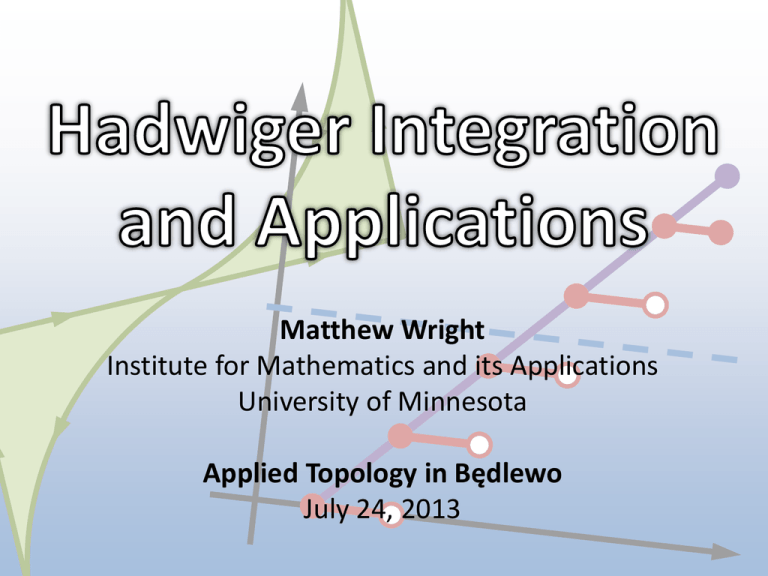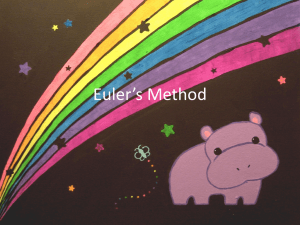Hadwiger Integral - Institute for Mathematics and its Applications
advertisement

Matthew Wright
Institute for Mathematics and its Applications
University of Minnesota
Applied Topology in Będlewo
July 24, 2013
How can we assign a notion
of size to functions?
Lebesgue integral
Anything else?
Euler Characteristic
Let 𝑋 be a finite simplicial complex containing 𝐴𝑖
open simplices of dimension 𝑖.
𝐴0 = number of vertices of 𝐴
𝐴1 = number of edges of 𝐴
𝐴2 = number of faces of 𝐴
etc.
Then the Euler Characteristic of 𝐴 is:
v
combinatorial
−1 𝑖 𝐴𝑖
𝜒 𝐴 =
𝑖
Key Property
For sets 𝐴 and 𝐵,
𝜒 𝐴∪𝐵 =𝜒 𝐴 +𝜒 𝐵 −𝜒 𝐴∩𝐵 .
This property is called additivity, or the
inclusion-exclusion principle.
𝐴
𝐴∩𝐵
𝐵
Euler Integral
Let 𝐴 be a “tame” set in ℝ𝑛 , and let 𝟏𝐴 be the
function with value 1 on set 𝐴 and 0 otherwise.
The Euler Integral of 𝟏𝐴 is:
ℝ𝑛
𝟏𝐴 𝑑𝜒 = 𝜒(𝐴)
For a “tame” function 𝑓: ℝ𝑛 → ℤ, with finite range,
ℝ𝑛
𝑓 𝑑𝜒 =
𝑐 𝜒{𝑓 = 𝑐} .
𝑐
set on which 𝑓 = 𝑐
Example
Consider 𝑓: ℝ → ℤ:
3
𝑓(𝑥)
2
1
ℝ𝑛
𝑓 𝑑𝜒 =
𝑐 𝜒{𝑓 = 𝑐}
𝑐
=1⋅0
←𝑐=1
+ 2 ⋅ (−1)
←𝑐=2
+3⋅2
←𝑐=3
=4
𝑥
Euler integral of 𝑓
Continuous Functions
How can we extend the Euler integral to a continuous
function 𝑓: ℝ → ℝ?
Idea: Approximate 𝑓 by step functions.
3
𝑓
𝑓
Make the step size smaller.
Consider the limit of the
2𝑓
Euler integrals of the
2
approximations as the
1
step size goes to zero:
1
lim
𝑚𝑓 𝑑𝜒
𝑥
𝑚→∞ 𝑚
Does it matter if we use lower or upper approximations?
1
∙
2
Continuous Functions
To extend the Euler integral to a function
𝑓: ℝ𝑛 → ℝ, define two integrals:
1
𝑓 𝑑𝜒 = lim
𝑚𝑓 𝑑𝜒
Lower integral:
𝑚→∞ 𝑚
Upper integral:
1
𝑓 𝑑𝜒 = lim
𝑚→∞ 𝑚
𝑚𝑓 𝑑𝜒
These limits exist, but are not equal in general.
Application
Local
Data
Global
Data
Euler Integration is useful in sensor networks:
• Networks of cell phones or computers
• Traffic sensor networks
• Surveillance and radar networks
How can we assign a notion
of size to functions?
Lebesgue integral
Euler integral
Anything else?
Intrinsic Volumes
The intrinsic volumes are the 𝑛 + 1 Euclidean-invariant
valuations on subsets of ℝ𝑛 , denoted 𝜇0 , … , 𝜇𝑛 .
𝜇0 : Euler characteristic
1
𝜇1 : “length”
𝜇𝑛−1 : ½(surface area)
0
𝜇𝑛 : (Lebesgue) volume
𝑉 = 𝑙𝑤ℎ
Example
Let 𝐾 be an 𝑛-dimensional closed box with side lengths
𝑥1 , 𝑥2 , … , 𝑥𝑛 . The 𝑖 th intrinsic volume of 𝐾 is
𝑒𝑖 (𝑥1 , 𝑥2 , … , 𝑥𝑛 ), the elementary symmetric polynomial of
degree 𝑖 on 𝑛 variables.
𝜇0 𝐾 = 𝑒0 𝑥1 , … , 𝑥𝑛 = 1
𝑥3
𝜇1 𝐾 = 𝑒1 𝑥1 , … , 𝑥𝑛
= 𝑥1 + 𝑥2 + ⋯ + 𝑥𝑛
𝜇2 𝐾 = 𝑒2 (𝑥1 , … , 𝑥𝑛 )
= 𝑥1 𝑥2 + 𝑥1 𝑥3 + ⋯ + 𝑥𝑛−1 𝑥𝑛
⋮
𝜇𝑛 𝐾 = 𝑒𝑛 𝑥1 , … , 𝑥𝑛 = 𝑥1 𝑥2 ⋯ 𝑥𝑛
𝑥1
𝑥2
Intrinsic Volume Definition
For a “tame” set 𝐾 ⊂ ℝ, the 𝑘th intrinsic volume
can be defined:
Hadwiger’s Formula
𝜇𝑘 𝐾 =
𝜒 𝐾 ∩ 𝑃 𝑑𝜆(𝑃)
𝐴𝑛,𝑛−𝑘
𝐴𝑛,𝑛−𝑘 is the affine Grassmanian of (𝑛 − 𝑘)–
dimensional planes in ℝ𝑛 , and 𝜆 is Harr measure
on 𝐴𝑛,𝑛−𝑘 with appropriate normalization.
Tube Formula
tube(𝐾, 𝑟)
𝐾
𝑟
The volume of a
tube around 𝐾 is a
polynomial in 𝑟,
whose coefficients
involve intrinsic
volumes of 𝐾.
Steiner Formula: For compact convex 𝐾 ⊂ ℝ𝑛 and 𝑟 > 0,
𝑛
𝜔𝑛−𝑗 𝜇𝑗 (𝐾)𝑟 𝑛−𝑗
𝜇𝑛 (tube 𝐾, 𝑟 ) =
𝑗=0
volume of unit (𝑛 − 𝑗)-ball
intrinsic volume
Hadwiger Integral
Let 𝑓 ∶ ℝ𝑛 → ℤ have finite range. Integration of 𝑓 with
respect to 𝜇𝑘 is straightforward:
ℝ𝑛
𝑓 𝑑𝜇𝑘 =
𝑐 𝜇𝑘 {𝑓 = 𝑐}
set on which
𝑓=𝑐
𝑐
Integration of 𝑓 ∶ ℝ𝑛 → ℝ is more complicated:
Lower integral:
ℝ𝑛
Upper integral:
ℝ𝑛
𝑓 𝑑𝜇𝑘
1
= lim
𝑚→∞ 𝑚
𝑓 𝑑𝜇𝑘
1
= lim
𝑚→∞ 𝑚
ℝ𝑛
ℝ𝑛
𝑚𝑓 𝑑𝜇𝑘
𝑚𝑓 𝑑𝜇𝑘
Hadwiger Integral
Let 𝑋 ⊆ ℝ𝑛 be compact and 𝑓 ∶ 𝑋 → ℝ+ bounded.
∞
𝑓 𝑑𝜇𝑘 =
X
𝜇𝑘 𝑓 ≥ 𝑠 𝑑𝑠 =
s=0
𝑓 𝑑𝜒 𝑑𝛾
𝐴𝑛,𝑛−𝑘 𝑃 ∩ 𝑋
slices
level sets
𝑓
𝑓
Example
Let 𝑓 𝑥, 𝑦 = 4 − 𝑥 2 − 𝑦 2 on 𝑋 =
𝑥, 𝑦 | 𝑥 2 − 𝑦 2 ≤ 4 .
Excursion set 𝑓 ≥ 𝑠 is a circle
of radius 4 − 𝑠.
𝑓
Hadwiger Integrals:
4
𝑠
𝑋
𝑓 𝑑𝜇0 =
1 𝑑𝑠 = 4
0
4
𝑋
𝑋
𝑓 𝑑𝜇1 =
0
16𝜋
𝜋 4 − 𝑠 𝑑𝑠 =
3
4
𝑋
𝑓 𝑑𝜇2 =
𝜋(4 − 𝑠) 𝑑𝑠 = 8𝜋
0
Valuations on Functions
A valuation on functions is an additive map
𝑣 ∶ {“tame” functions on ℝ𝑛} → ℝ.
For a valuation on functions, additivity means
𝑣(𝑓 ∨ 𝑔) + 𝑣(𝑓 ∧ 𝑔) = 𝑣(𝑓 ) + 𝑣(𝑔),
pointwise max
pointwise min
or equivalently,
𝑣(𝑓 ) = 𝑣(𝑓 ⋅ 𝟏𝐴 ) + 𝑣(𝑓 ⋅ 𝟏𝐴𝑐 )
for any subset 𝐴 and its complement 𝐴𝑐 .
Valuations on Functions
A valuation on functions is an additive map
𝑣 ∶ {“tame” functions on ℝ𝑛} → ℝ.
Valuation 𝑣 is:
• Euclidean-invariant if 𝑣(𝑓 ) = 𝑣(𝑓(𝜑)) for
any Euclidean motion 𝜑 of ℝ𝑛 .
• continuous if a “small” change in 𝑓
corresponds to a “small” change in 𝑣(𝑓)
(a precise definition of continuity requires a
discussion of the flat topology on functions).
Hadwiger’s Theorem for Functions
(Baryshnikov, Ghrist, Wright)
Any Euclidean-invariant, continuous valuation 𝑣
on “tame” functions can be written
𝑛
𝑣 𝑓 =
𝑛
ℝ
𝑘=0
𝑐𝑘 𝑓 𝑑𝜇𝑘
for some increasing functions 𝑐𝑘 : ℝ → ℝ.
That is, any valuation on functions can be
written as a sum of Hadwiger integrals.
How can we assign a notion
of size to functions?
Lebesgue integral
Euler integral
Hadwiger Integral
Any valuation on functions can be written in
terms of Hadwiger integrals.
Surveillance
𝑓
3 2
0
1
2
0
0
1
2
1 3
2
3
2
1
1
0
2
1
Suppose function 𝑓 counts the
number of objects at each
point in a domain.
Hadwiger integrals provide
data about the set of objects:
𝑓 𝑑𝜇0 gives a count
𝑓 𝑑𝜇1 gives a “length”
𝑓 𝑑𝜇2 gives an “area”
etc.
Cell Dynamics
As the cell structure changes by a certain process that
minimizes energy, cell volumes change according to:
𝑑𝜇𝑛
1
𝐶 = −2𝜋𝑀 𝜇𝑛−2 𝐶𝑛 − 𝜇𝑛−2 (𝐶𝑛−2 )
𝑑𝑡
6
𝑛-dimensional structure
(𝑛 − 2)-dimensional structure
Image Processing
Intrinsic volumes are of utility in image processing.
A greyscale image can be viewed as a
real-valued function on a planar
domain.
With such a perspective, Hadwiger
integrals may be useful to return
information about an image.
Applications may also include color or
hyperspectral images, or images on
higher-dimensional domains.
Percolation
Question: Can liquid flow through a porous material from
top to bottom?
ℝ3
Functional approach:
Define a permeability
function in a solid
material.
Hadwiger integrals may
be useful in such a
functional approach to
percolation theory.
Surveillance
Let 𝑓: 𝑇 → ℤ count objects locally in a domain 𝑇 ⊆ ℝ2 .
𝑓
3 2
0
1
2
0
0
1
1 3
? 2 ?
3
2
1
1
0
?2
2
1
Then the Euler integral gives
the global count:
𝑇
𝑓 𝑑𝜇0 = 5
What if part of 𝑇 is not
observable?
Idea: Model the function with
a random field. Estimate the
global count via the expected
Euler integral.
Random Field
Intuitively: A random field is a function whose value at any
point in its domain is a random variable.
Formally: Let Ω, ℱ, ℙ be a probability space and 𝑇 a
topological space. A measurable mapping 𝑓: Ω → ℝ𝑇 (the
space of all real-valued functions on 𝑇) is called a realvalued random field.
Note: 𝑓(𝜔) is a function, (𝑓 𝜔 )(𝑡) is its value at 𝑡.
Shorthand: Let 𝑓𝑡 = (𝑓 𝜔 )(𝑡).
Expected Hadwiger Integral
Theorem: Let 𝑓 ∶ 𝑇 → ℝ𝑘 be a 𝑘-dimensional Gaussian
field satisfying the conditions of the Gaussian Kinematic
Formula. Let 𝐹 ∶ ℝ𝑘 → ℝ be a piecewise 𝐶 2 function. Let
𝑔 = 𝐹 ∘ 𝑓, so 𝑔 ∶ 𝑇 → ℝ is a Gaussian-related field. Then
the expected lower Hadwiger integral of 𝑔 is:
𝔼
𝑇
𝑔 𝑑𝜇𝑖
dim 𝑇 −𝑖
𝑗=1
= 𝜇𝑖 𝑇 𝔼 𝑔 +
𝑖+𝑗
2𝜋
𝑗
−𝑗/2 𝜇
𝑖+𝑗
𝛾
𝑇
ℝ
ℳ𝑗 {𝐹 ≥ 𝑢} 𝑑𝑢
and similarly for the expected upper Hadwiger integral.
Computational Difficulties
Computing expected Hadwiger integrals
of random fields is difficult in general.
𝔼
𝑇
𝑔 𝑑𝜇𝑖
dim 𝑇 −𝑖
𝑗=1
= 𝜇𝑖 𝑇 𝔼 𝑔 +
𝑖+𝑗
2𝜋
𝑗
−𝑗/2
𝜇𝑖+𝑗 𝑇
ℝ
𝛾
ℳ𝑗
{𝐹 ≥ 𝑢} 𝑑𝑢
intrinsic volumes: tricky,
but possible to compute
Gaussian Minkowski functionals: very
difficult to compute, except in special cases
Challenge: Non-Linearity
Consider the following Euler integrals:
𝑦=1
1
1
𝑦=𝑥
𝑥
𝑥 𝑑𝜒 = 1
[0, 1]
1
𝑦 =1−𝑥
𝑥
(1 − 𝑥) 𝑑𝜒 = 1
[0, 1]
𝑥
1 𝑑𝜒 = 1
[0, 1]
Upper and lower Hadwiger integrals are not linear in general.
Challenge: Continuity
A change in a function 𝑓 on a small set (in the Lebesgue) sense
can result in a large change in the Hadwiger integrals of 𝑓.
2
1
2
𝑓
1
𝑔
𝑥
𝑓 𝑑𝜒 = 1
𝑥
Similar examples
exist for higherdimensional
Hadwiger
integrals.
𝑔 𝑑𝜒 = 2
Working with Hadwiger integrals requires different intuition
than working with Lebesgue integrals.
Challenge: Approximations
How can we approximate the Hadwiger integrals of a
function sampled at discrete points?
𝑓: 0,1
2
→ℝ
triangulated approximations of 𝑓
Hadwiger integrals of interpolations of 𝑓 might diverge,
even when the approximations converge pointwise to 𝑓.
Summary
• The intrinsic volumes provide notions of size for sets,
generalizing both Euler characteristic and Lebesgue
measure.
• Analogously, the Hadwiger integrals provide notions of
size for real-valued functions.
• Hadwiger integrals are useful in applications such as
surveillance, sensor networks, cell dynamics, and image
processing.
• Hadwiger integrals bring theoretical and computational
challenges, and provide many open questions for future
study.
References
• Yuliy Baryshnikov and Robert Ghrist. “Target Enumeration via Euler
Characteristic Integration.” SIAM J. Appl. Math. 70(3), 2009, 825–844.
• Yuliy Baryshnikov and Robert Ghrist. “Definable Euler integration.” Proc. Nat.
Acad. Sci. 107(21), 2010, 9525-9530.
• Yuliy Baryshnikov, Robert Ghrist, and Matthew Wright. “Hadwiger’s Theorem
for Definable Functions.” Advances in Mathematics. Vol. 245 (2013) p. 573-586.
• Omer Bobrowski and Matthew Strom Borman. “Euler Integration of Gaussian
Random Fields and Persistent Homology.” Journal of Topology and Analysis,
4(1), 2012.
• S. H. Shanuel. “What is the Length of a Potato?” Lecture Notes in Mathematics.
Springer, 1986, 118 – 126.
• Matthew Wright. “Hadwiger Integration of Definable Functions.” Publicly
accessible Penn Dissertations. Paper 391.
http://repository.upenn.edu/edissertations/391.







